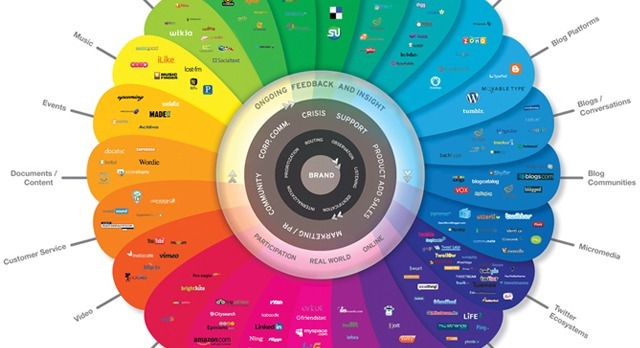Are you just starting out with social media and interested in developing a content marketing strategy? After you’re done setting up your blog and numerous social media outlets, the next step is to create a clear and concise strategy for what types of posts you will make, and why.
What Are Your Goals?
Why create content in the first place?
First, make a list of goals and direct your attention toward attaining them.
Some examples of content strategy goals would be:
- To validate yourself and your company – A strong online presence through a blog and your social media profiles shows that you’re an active, interesting and viable online presence to follow.
- To gain recognition as an industry leader. More quality content means the more likely others will share it. This is particularly important for advisory businesses who are selling their advice, consulting and unique services.
- To get more reach and gain more followers. More followers means a larger audience.
- To find out what works best for your company. Use tools like Google Analytics to track what (email campaigns, social media posts, blog posts) works best.
- SEO – The more organic content you push out, the more Google likes you— ultimately meaning a higher search rank (for relevant keywords).
- To explore reaching a new target industry.
- To ultimately generate leads.
A System of Check and Balances
But who will do all of this? For most business owners and CEOs, being a large part of the content strategy’s direction but less involved in the actual process is hard to do. The main concern of the CEO is that he or she wants to make sure their content is parallel with the brand, but often, the CEO is too busy managing other aspects of the business. Since content strategy and constant contact with the audience through social media is a new aspect of online marketing, CEOs are wary about where to even begin.
The best way to remedy this situation is to appoint a social media and content strategist. This individual must become well versed in your company’s overall brand, voice and audience. And clear guidelines and goals need to be established with CEO input. The social media and content strategist will give the CEO peace of mind by checking in regularly and voicing any questions or concerns when gathering or creating content.
Create A Content Calendar
A content calendar is much like a production timeline. Decide what you want to create, estimate how long it will take, decide when to post and where. Before you begin actually constructing your content calendar, you may want to look at some tools that will make your efforts a lot easier.
- Google drive – With Google Drive all of your documents live in the cloud and can be accessed anywhere. It is compatable for both pc and mac, iOS and android. You can create word documents, excel sheets, presentations and more.
- Working as a team – In addition to being able to store files in the cloud, Drive allows you to collaborate with others working on the same projects. Being able to share with all involved allows for seamless sharing of information, more organization and less mess. Relating Drive back to a content calendar, if multiple people are working on creating and scheduling content, Drive is the most efficient way to work.
- Google Calendar – For deciding what to post when, Google Calendar is a great way to share with everyone involved what you’re planning and any changes you make. It keeps everyone on the same page and allows for more time spent actually working on content and less time sifting through e-mails.
- Scheduling Tools – Social Media scheduling tools like Hootsuite allow you to schedule posts for various social media channels including Facebook, Twitter, LinkedIn, Google+, and Foursquare. Hootsuite allows you to schedule your content so that it posts automatically at the time you set. Why use this service? For example, you have a particularly busy week ahead and know you won’t have time to actually sit down and post. If you schedule the posts prior, Hootsuite takes care of actually pushing the posts out. This frees you up to be wherever you need to be but also allows you (and your company) to be present on your social media channels.
- Although Hootsuite sends out your posts for you, let it be known that this doesn’t mean you shouldn’t check-in on your efforts. If you get a comment or a tweet, you need to respond! If relevant news items come up, post or respond appropriately. That’s the whole point of social media – creating a discussion. Don’t let services like Hootsuite make you think it’s okay to just check back once a week. It’s about engagement. Social Media should really be a daily habit.
But What Types of Things Should I Post?
The best posts are content which you create yourself such as blog posts, graphic- or image-supported stories or videos. Some examples of relevant posts are how-to guides, tips and blog posts with commentary on current events related to your industry.
Relevant posts which you have found from news sources, industry publications, YouTube, or really anywhere else on the internet. As long as they are relevant, meaningful, promote sharing or conversation and entertain or educate, you can post it (with permission or credit attributed, of course)!
Whether created yourself or re-posted from others, the content you post should be interesting enough for the audience to want to read, watch or share, or educational enough that those in your industry can’t pass up reading it and commenting about it afterwards.
Does all of this content strategy business sound extremely high maintenance? It is. It takes time, effort and ingenuity. Posting boring things that won’t get commented on, shared or even read is a waste of time. And if you do this consistently, you will lose readers. It’s really better to create quality organic content that represents your brand and is useful, entertaining or interesting for your target market, than to churn out short, easy and boring.
If you’re screaming inside, “Wait, I still don’t know exactly what to post!”, you have a few options:
- Check out your industry associations, publications and related businesses. See what others in your industry are doing and use the findings as inspiration.
- Get advised. Go to someone who knows what they’re doing. The term “Social Media Consultant” may sound laughable because your CEO scoffs at the word “tweet” but when you don’t know where to start, start with someone who does.
- Talk to your staff. Some of them are already super connected and very active in a variety of social media. Discuss guidelines and rotating blog authors; get them involved.
- Use your ambassadors. Every business has some tried and trued clients, vendors, friends and other relationships. Some of them have great ideas or even could be willing to guest post once in a while. They will certainly help spread the word if you ask.
Your Blog – The Content Powerhouse.
Depending on your company’s content strategy goals, you can treat your blog a couple of different ways.
1.) Post only what your company creates. (Blog posts, videos, graphics, company news, client news, portfolio snippets, etc.)
2.) Post things you think are interesting and relevant (data visualization, videos, how-to guides) made by others.
3.) Most commonly, a combination of the two.
Regardless of your choice of blog protocol, your blog should be where your company’s voice is established. Where 140-character tweets and Facebook posts lack the full picture, your blog picks up the slack. The blog is where you can dive in with more details and illustrate points you want to make, comment on current events relevant to your industry, and post the content you have created.
Make Your Content Easy to Find
Don’t just write a blog post and let it sit there. Unless you’re a largely popular blog, you probably don’t have a steady audience frequenting it. And if you do, you probably don’t need to be reading this because you have it all figured out! Pushing your blog post out through your social media channels allows for a lot more people to see that you’ve posted something and that you want them to check it out.
For those who aren’t yet a part of your social media audience, making it easy for your content to be found through key words is important. You can use Google’s Keywords Tool to find the balance between a high search volume and low competition. Google has a short description and video about using the keyword tool which can get you started.
Measure Your Efforts
Measuring what works best should absolutely be a part of your content strategy. Using google analytics to track your ROI with social media not only validates that what you’re doing is working but also allows you to craft your next move around what works best for your particular company. For example, if you notice a certain email campaign has received a lot of click throughs, analyze it. What was your subject line? Did you use a different image in the email? Did you offer a deal?
Another way of analyzing your efforts is with Facebook Insights, Facebook’s own analytics tool built in to your Facebook Page. Facebook Insights will show you what posts are performing the best (getting the most comments, clicks, likes, etc.)
If you’ve added Pinterest to your marketing mix, they’re recently added an analytics tool of their own. Pinterest Analytics is very similar to the Facebook Insights tool and allows you to measure based on four categories: Site Metrics, Most Recent, Most Repinned and Most Clicked.
You’re On Your Way
By establishing attainable goals, deciding on what to post, appointing a content manager, creating a content calendar, generating meaningful content, utilizing your blog, and finally, measuring (and tweaking) all of your efforts, you’re now well on your way to having a powerful online presence. Keep it up! A large part of content strategy is perseverance. Keep posting even though no one is responding. Keep measuring your email and social media campaigns. Be consistent. Discovering what isn’t working will push you toward understanding what does.
– Tara Urso, social media and content strategist
image above is Brian Solis’ Conversation Prism, Version 3.0 by Brian Solis and JESS3.



2 Comments
Very insightful information, Tara! My favorite quote – “Discovering what isn’t working will push you toward understanding what does.”
Hey Ethan,
Thanks so much for the comment! As you know, a little trial and error is essential to a great content marketing strategy.